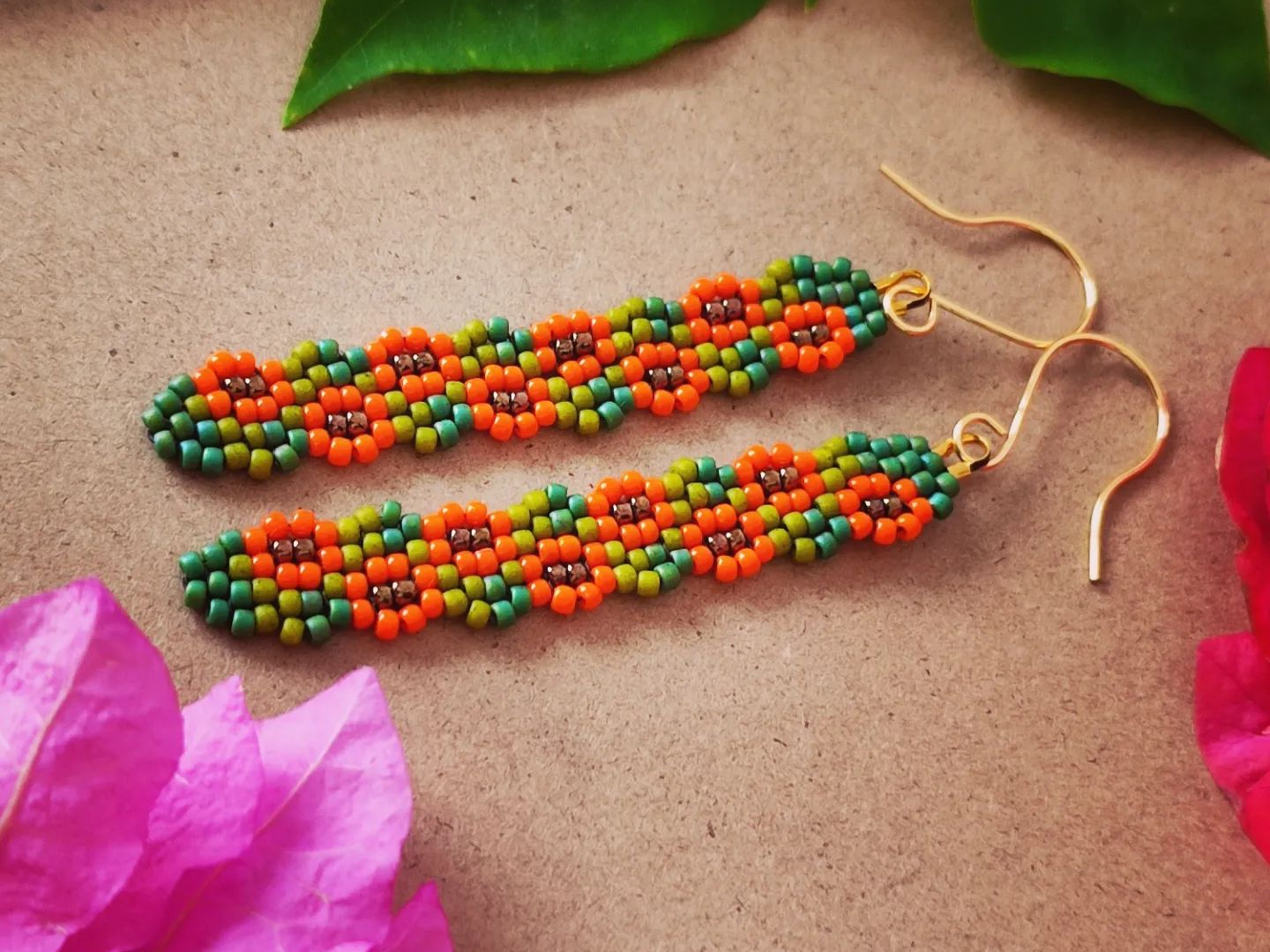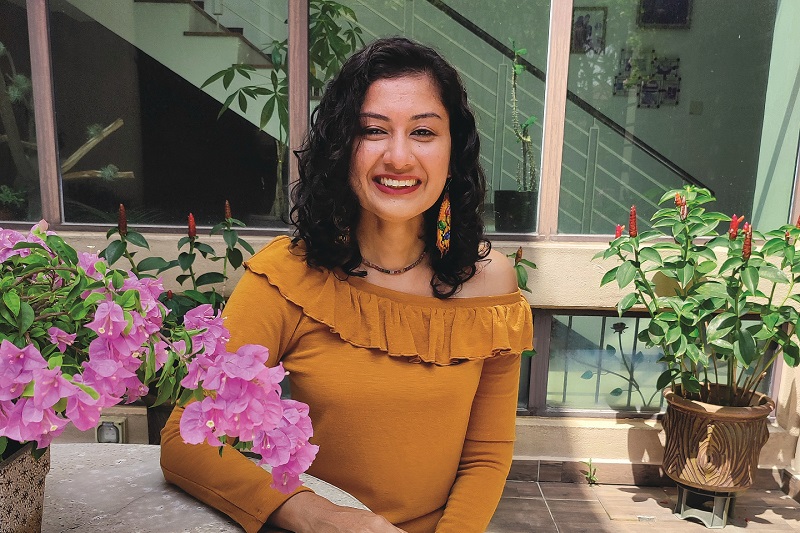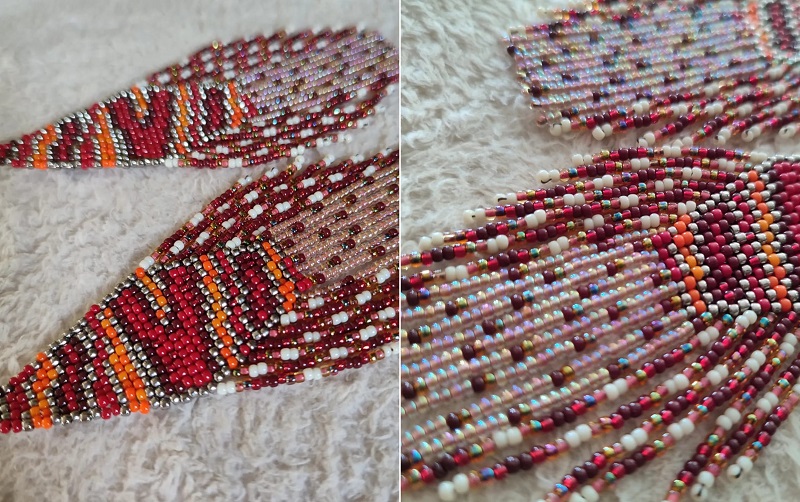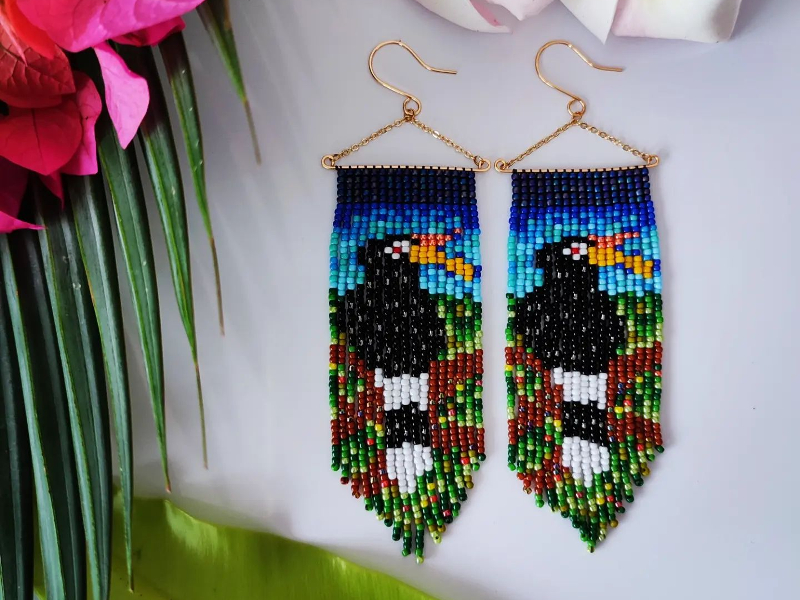
A long and slim pair of earrings inspired by flowers (All photos: Bead-it by Sharm K)
Wearing different kinds of jewellery such as necklaces, bracelets, rings or earrings is no doubt a great way to elevate and complete an outfit. Variety aside, some people have accessories they are particularly attached to. For Sharmila Kaur, it is earrings.
“I have loved earrings for as long as I can remember,” she says. “Beaded jewellery in Malaysia comes mainly from Sarawak. I went there some time ago and was fascinated by the array of local accessories. I just didn’t think I would be making them one day.”
Sharmila made the courageous decision to leave her job as an internal auditor after 14 years as she was looking for a more fulfilling and fun endeavour. She began selling hand-crocheted bags that she had imported from Mexico. “The business was doing quite well. Then, I thought of selling more accessories. My husband told me, ‘Why don’t you make something on your own? Instead of buying and selling, you could build a skill and sell it locally so you don’t have to rely on someone outside the country’.”
Sharmila’s deep love for beaded jewellery drove her to try making the accessories by hand. She relied on YouTube to acquire the basic skills needed to kick-start her business. “You can learn every single thing from the platform. So, that’s how I learnt the techniques to make beaded accessories,” she says. “It was difficult at first because I was still practising and learning. Eventually, it got better.”
img_20220801_113321.jpg

Sharmila has limited options when it comes to the beads she can use as there is difficulty finding such materials locally. Currently, she opts for Japanese seed beads — sourced mostly from Sarawak — which come in different finishes including metal, shiny and matte. “There are two types of beads, round and cylindrical. But the latter is hard to get in Malaysia. The majority of beaders in the US and Europe use Delicas beads because they are nicer. Here, you have to work with limited colours and designs. It is difficult but workable. So, I rely on round beads a lot.”
Creating one-of-a-kind pieces not only ensures exclusivity, but also keeps the 44-year-old excited about her creations. “I normally don’t make them again after selling the pieces. I prefer it that way because it keeps my life interesting, as I get to do new things,” says Sharmila, adding that customers can request for any previous designs that they see on her Facebook page or Instagram account. “I don’t mind remaking a similar style. But they’re mostly new and unique.”
Sharmila finds creative ideas from her surroundings such as nature and landscapes. Patterns that she has experimented with include songket, watermelon, peacock and scallop. One of her latest earrings was inspired by a lionfish she saw during her trip to Sipadan, Sabah. “I went snorkelling. While underwater, there was this lionfish dancing between corals. It was really beautiful. The first thing I did when I came back from the holiday was to make lionfish earrings.”
bead_it_fish.jpg

Making beaded earrings entails hours — between three and eight — of work, depending on their intricacy. In one week, Sharmila crafts at most two pairs. Meanwhile, drawing requires additional time that she does not keep track of as inspiration strikes at random times. She utilises a digital art tool called Sketchbook, which allows her to sketch and colour her designs. “Sometimes, I draw. Then, I do something else before I come back to it. It really depends on whether I have the idea then.”
Sharmila occasionally makes necklaces of the same kind and quality — colourful, quirky designs. “Between earrings and necklaces, I would say the former is a bit more difficult to work with because you have to make the same pattern on both sides. It gets a bit boring lah because you are doing the same thing again, but it is still interesting.”
Bead-it by Sharm K was launched in January 2020, a few months before the first lockdown. While many businesses were badly affected by the pandemic, Sharmila had a lot of new customers as they now had time to discover her creations. During this period, shopping habits quickly shifted from offline to online and the jewellery maker was grateful her enterprise was still building a reputation, albeit slowly. “People spent more time surfing, so I actually made a lot of sales during the pandemic. It slowed when the lockdowns were lifted as everyone started going out,” she says.
305739819_487802950020202_2517030917558961954_n.jpg

Looking at the trend, Sharmila realised the importance of expanding her brand footprint beyond the digital world. Hence, Bead-it had its first offline presence at a pop-up bazaar organised by Pasar KL near Pasar Seni in Kuala Lumpur. It shared a booth with another local brand selling artisanal soaps. “My friend told me I needed to go out there and not rely fully on digital. That helped with sales as the majority of my customers were tourists,” she observes.
The experience led the business owner to discover new things about her brand such as customer demographics. “It gave me information on the kinds of clients I should target. The majority of those who went to the bazaar were young and they were not interested in this type of jewellery. I need to look for those who appreciate handmade products. It is quite difficult, especially in Malaysia. I am not the only one saying this; some makers also say the same thing.”
A huge fan of the late King of Pop, Michael Jackson, Sharmila played around with his hit song Beat It when deciding on a name for her business. Bead-it today is loved by customers for the bold colours it uses and beaded designs. “They say it is different from other jewellery. It is like wearing art on your ears.”
This article first appeared on Aug 29, 2022 in The Edge Malaysia.


